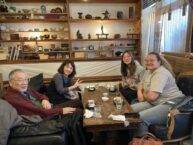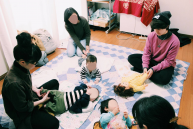I have always sensed a certain universality to the world of dance in the 4 places where I had trained before coming to Japan (Boston, New York, Los Angeles and Brazil), but it was incredible to have a chance to confirm that in Japan. Of course there are differences, but probably the most interesting thing about hip hop studios is that instead of conserving the differences between Japanese and US culture, they bring both of these worlds into a third, which feels incredibly familiar to anyone who has experienced it anywhere around the world. We stretch, practice some techniques which the teacher deems useful for that day’s choreography, learn around 30 seconds of choreography together and dance it in small groups by the end of the class. As one group dances, the others form a circle around them to cheer them forward, and finally the teacher might choose to perform it alone at the end of the class either for the students’ inspiration, study, or for the teacher’s own enjoyment. Both of these descriptions could describe in some detail the 5 environments I have experienced so far, including Japan, yet because of the Japanese personality, I think, the moments after the class have been considerably different.
This is also influenced by the fact that this studio is smaller than the enormous studios in Tokyo, for example, but it is a well established culture for the teacher to stay and talk to the students and build relationships after the class. In this case my teacher happens to be famous, a member of the hip hop team that largely defined street dance as it is in Japan. Today Japan is the second most acknowledged country in the world of hip hop, yet the intimidating atmosphere I felt in LA was not at all present. What’s more, in contrast with LA, for example, there was no pressure for me to change my personality. I am not claiming to be normal or cool around all of my friends but I am indescribably shy and clumsy when entering new groups, especially those which have a clear distinction with the groups I integrate. For example, I can find several commonalities with other KCJS students that make me feel like we have a similar standing: we are all college students, currently studying in the US, living in a foreign and completely different country and under the same program, taking similar classes. In the studio, however, that is different. I am from Brazil, have moved to the US but now am living in Japan taking classes with a famous Japanese professional dancer in her country, with students she already knows and are part of a tight knit community. In LA the pressure is even more indescribable, you might be rehearsing in one room while Beyonce is literally in the room next to you, you want to be hired by her but you know it probably won’t happen because you’re disputing that job with the other 100 amazing dancers which currently share the studio with you, plus those rehearsing in different studios and those who come all around the world just for these auditions – every class feels like a simulated audition. Because of this imposing culture, it is demanded that you impose yourself: be confident, find your style, jump to the front of the room to be seen, talk to the teacher because you are the one who has something to gain and if you are shy, it’s because you haven’t developed your social skills well enough – well, tough luck for me.
Thank god I found this class, this teacher I had watched on Youtube and Instagram from Brazil and the US simply approached me and talked as I was about to leave the studio. Not only that, but she waited at the door for me so I wouldn’t go without us meeting. Of course the fact that she is famous imposes limits on how fast one can build a relationship, since fame attracts many insincere friends. That forced friendship, however, was sometimes exactly what was demanded in LA, and I had no idea how to act, because I would stumble through words while looking down and ultimately just leave with a handshake and “thank you for class.” This teacher, however, more famous than many of my LA teachers, sat me in the together with their close knit circle and asked about me, my life, what I did, why I had come to Japan, why I was “so umai at Japanese” and complimented the thing I care the most about, my dance, even as I am unable to dance properly because of my operated hips, saying she was looking forward to see me recovering.
Indeed the Japanese have a different way of moving, and naturally we talked a lot about those differences as well. In the west, especially in hip hop, dancers tend to focus on their upper body, which has most of the gestural movement and perhaps is easier to notice – although now I focus way more on the lower body. The Japanese, however, seem to be the opposite: the arms seem not as important, but by focusing on the lower body their dance has a stability and fluency that is really difficult to find. If you watch a Japanese hip hop dancer, probably two things will stand out: their connection with the music and their soft knees. Knees give you stability and impulse when you are dancing, yet they are usually naturally locked and stiff – that’s actually a good way of guessing for how long has been practicing, when you are in America. Here, however, the softness in the legs seems to happen more naturally, which is interesting for me, too, as someone who doesn’t have that specific aspect as naturally as the Japanese. That is not to say, however, that the Japanese are inherently better, just that they seem to have one good natural quality. My teacher joked all the time, however, about how the Japanese were anxious compared to Americans, and that a music that started on 60 bpm (beats per minute) would become 120 in a minute if it depended on Japanese. She has lived in LA as well, and also said the quietness of the Japanese sometimes give a weird feeling to the performer – even when the audience is enjoying it. Especially in America people tend to scream all the time during hip hop performances, while in Japan it’s normal for them to say nothing at all, and once you are used to America that can be quite scary.
The thing I am most grateful for, however, was for their welcoming spirit and acceptance of my clumsy, quiet way in the studio, which was answered with comments like “So respectful!” or (maybe in the worst case) “Mecha Kawaii Yan (Really cute right??),” because I probably look like a kid transferring schools at elementary school. But I have done that before, quite a few times, actually, and perhaps because of Japan’s culture of listening attentively, then respond, it was the first time I felt those characteristics were welcomed, so I would feel incredibly comfortable inviting anyone there for their first dance class. She gave us freedom to choose what we wanted to work on during class ‘I am giving you raw material but if you think that’s too stressful you can just learn one thing, and if you think that’s too easy you can make it more challenging, it’s your class and I am happy to see you do what you want with it.’ In any case you are guaranteed to be welcomed and congratulated by her in the end with a warm “Otsukaresama deshita!” and praise of whatever she can compliment in you – even if it’s your courage for taking a different class. Anyone that decides to do this, I think, would have an amazing first view of the hip hop world, from one of it’s most welcoming countries.


